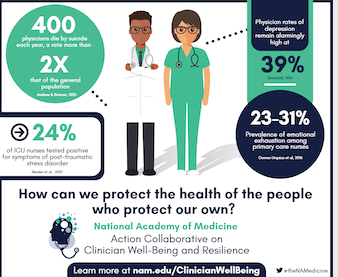
May 21, 2019
Positive Work Environments: Good for Nurses, Patients, and Hospitals

Courtesy of the National Academy of Medicine.
Clinician burnout—emotional exhaustion, difficulty relating to others, and a lack of feelings of accomplishment—is well documented, and it has serious consequences for nurses, their patients, and the hospitals and health systems where they work. Burnout is associated with high turnover, substance abuse, suicidal ideation, and in some cases, medical error.
With so much attention being paid to mindfulness, meditation, better sleep, and other strategies for promoting individual well-being, it’s easy to lose sight of the institutional factors that can cause burnout in the first place. A new meta-analysis from the University of Pennsylvania’s Nursing Center for Health Outcomes and Policy Research turns the spotlight on the nurses’ work environments, defined as “the nurse’s managerial and interprofessional relationships, the nurse’s role in institutional decisions and quality improvement, and nurse staffing and patient care resources.”
Led by Eileen T. Lake, PhD, MSN, FAAN, the Penn meta-analysis synthesizes 16 years of recent research, finding consistent and significant associations between poor work environments and negative outcomes for both nurses and patients. These associations are especially pronounced in regard to nurse job dissatisfaction, burnout, and plans to leave the workplace. Poor work environments are also associated with increased patient mortality and adverse events such as hospital-acquired infections.
Writing in the journal Medical Care, Lake and her co-authors noted that nurses are often “the last line of defense against medical errors and unsafe practices.” Given this critical role, it is perhaps not surprising that roughly a quarter to a third of nurses report “emotional exhaustion,” a key component of burnout.
ECRI Institute, which promotes evidence-based patient safety and publishes an annual list of Top 10 Patient Safety Concerns, ranked burnout and its impact on patient safety third in 2019. This assessment comes 15 years after the groundbreaking 2004 Institute of Medicine report Keeping Patients Safe: Transforming the Work Environment of Nurses, suggesting a continuing need to transform work environments that nurses perceive as unsafe for patient health and clinician well-being.
As Lake and her colleagues conclude, “The evidence supports the unique status of the work environment as a foundation for both patient and provider well-being. Accordingly, the work environment offers a powerful target and improvement efforts warrant the resources and attention of health care administrators.”

This infographic is one of numerous resources developed by the Action Collaborative on Clinician Well-Being and Resilience at the National Academy of Medicine. Courtesy of the National Academy of Medicine.
Another study from Penn Nursing suggests that investments in improving work environments pay off. A survey of nurses in four large states found that burnout decreased by 12 percent over a decade at hospitals where nurses reported improvements in patient safety and the quality of care.
Addressing the institutional causes of burnout and other threats to clinician well-being may also benefit a health system’s bottom line. Both studies found a positive association between well-functioning nurse work environments and patient satisfaction scores. Such scores are factored into hospital reimbursement under some newer payment models.
Learn More
- On May 29, the National Academy of Medicine (NAM) will hold a meeting in Chicago to discuss making clinician well-being a national priority. Register for the live webcast.
- Visit NAM’s Action Collaborative on Clinician Well-Being and Resilience, a network of more than 60 organizations committed to reversing trends in clinician burnout. The website has a wealth of information and resources, which can be accessed through its Knowledge Hub.
- Read “Ten Years After Keeping Patients Safe: Have Nurses’ Work Environments Been Transformed?” This 2014 brief from Charting Nursing’s Future showcases research, policies, and tools with the potential to advance the transformation of nurses’ work environments.
- Revisit the groundbreaking 2004 Institute of Medicine report Keeping Patients Safe: Transforming the Work Environment of Nurses. It found that “the typical work environment of nurses is characterized by many serious threats to patient safety.”
